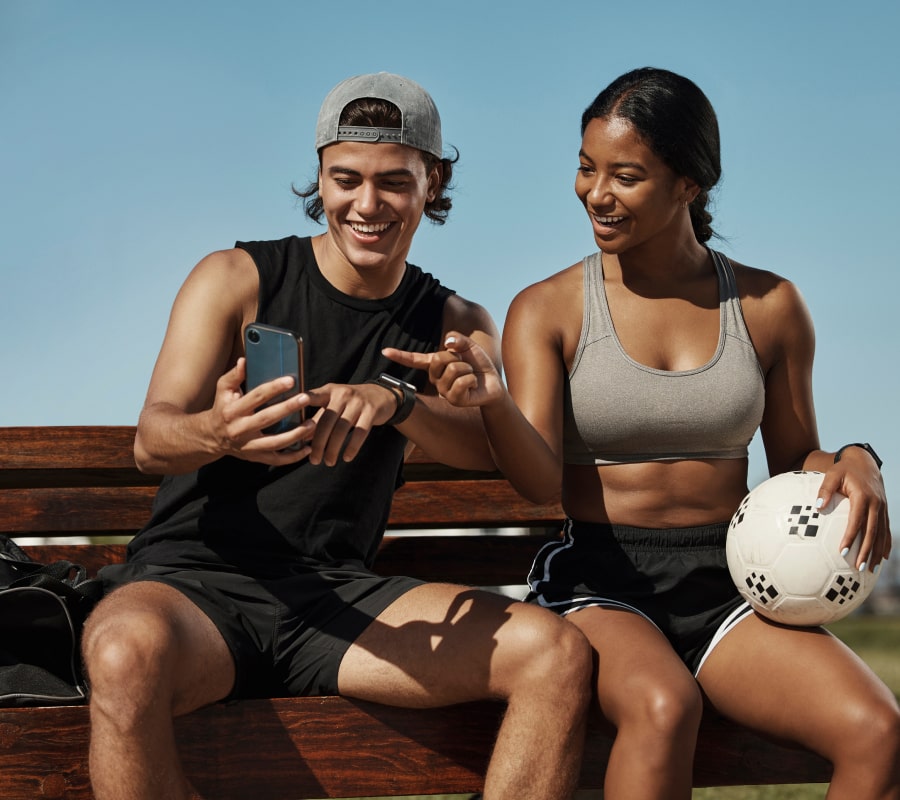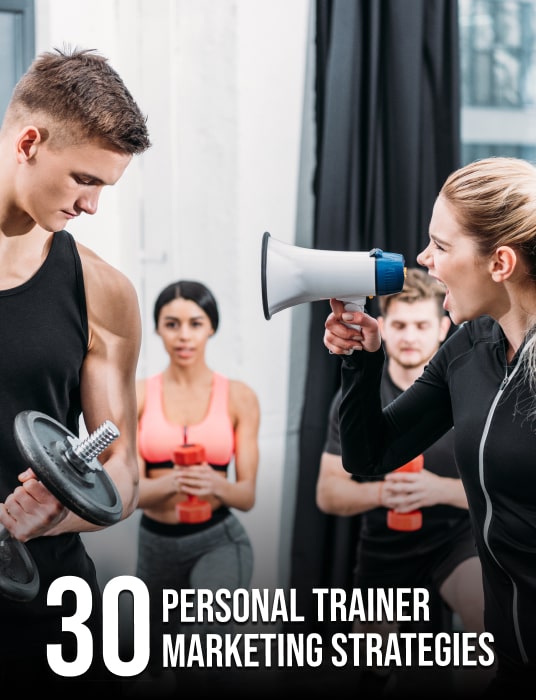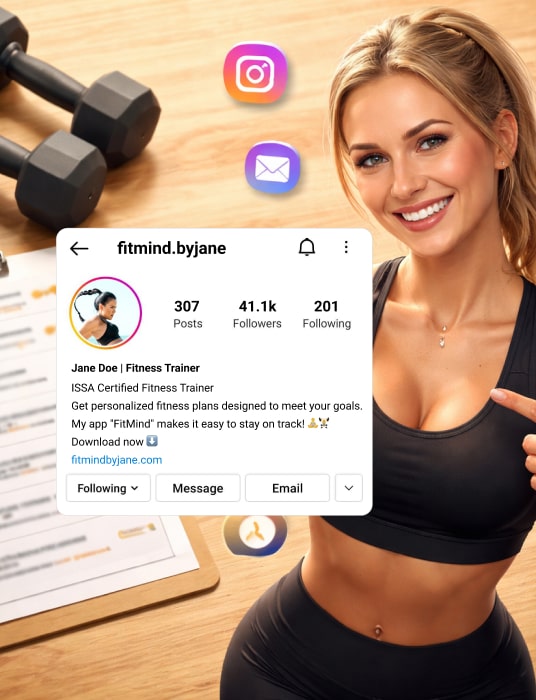Are You Earning Up to Your Potential?
Most personal trainers are undervaluing their time and skills. Our Personal trainer Revenue Calculator helps you find out what you should be making, and how to get there.
No guesswork. Just real numbers.
.jpg)
How Much Do Fitness Influencers Make in 2025? The Complete Income Guide for Fitness Professionals
The fitness industry has undergone a dramatic transformation over the past decade, with social media platforms becoming the primary stage for fitness professionals to showcase their expertise and monetize their knowledge. As we navigate through 2025, the question on every fitness coach's mind is: how much money as a fitness influencer can you make?
The fitness influencer salary landscape varies significantly based on numerous factors, including follower count, engagement rate, niche specialization, and monetization strategies. Understanding these income dynamics is crucial for fitness coaches, gym owners, and aspiring fitness influencers who want to establish sustainable revenue streams that can be leveraged in the digital fitness world.
Many fitness influencers generate substantial income through diverse revenue streams, including sponsored posts that fitness brands offer, brand deals that fitness professionals secure, and their own fitness app development. The average fitness influencer's income depends heavily on their ability to create valuable content that resonates with their target audience while building a strong personal brand in the competitive fitness niche.
The Current State of Fitness Influencer Income in 2025

The fitness influencer income potential in 2025 has reached unprecedented levels, with top-earning fitness creators earning hundreds of thousands or millions of followers, and even seven figures annually. The earnings of Instagram fitness influencers and YouTube fitness creators have shown particularly strong growth, with influencer tier earnings data for 2025 revealing unprecedented monetization opportunities.
The fitness industry has become increasingly competitive, with many fitness influencers collaborating and offering online coaching services to differentiate themselves across social media platforms. However, those who have established themselves as authorities in their fitness niche continue to see substantial returns on their content investment through strategic influencer marketing approaches.
Understanding the current market conditions is essential for anyone looking to enter the fitness influencing space. The landscape has matured significantly, necessitating more sophisticated marketing strategies and higher-quality, engaging content to differentiate oneself among the millions of fitness professionals competing for audience attention in the evolving fitness community.
Breaking Down Average Fitness Influencer Income by Follower Count

Micro-Influencers (1 K- 10 K Followers)
Starting fitness influencers with smaller followings shouldn't underestimate their earning potential. Influencers with a small audience (generally fewer than 10,000 followers) can earn around $150 per post for sponsored content. While this may seem modest, micro-influencers often have higher engagement rates, making them attractive to fitness brands seeking authentic connections with their target audiences.
Many fitness brands recognize the value of collaborating with micro-influencers who maintain close relationships within their fitness communities. These influencers typically earn through a combination of sponsored posts, affiliate marketing for fitness products, and promoting their own fitness programs.
The key advantage for micro-influencers lies in their ability to maintain close relationships with their audience. This intimacy translates to higher conversion rates when promoting fitness products or online coaching services, making them valuable partners for fitness brands despite their smaller reach in the competitive fitness world.
💪 Got an idea for a brand? Let's bring it to life.
Launch your own fitness app with FitBudd in minutes!

💪 Got your brand name? Let’s bring it to life.
Launch your own fitness app with FitBudd in minutes!


88% trainers worldwide gave us 5 stars
Transform your fitness business with the power of your branded app on iOS and Android.
Try for FREEMid-Tier Influencers (10 K- 100 K Followers)
Mid-tier fitness influencers represent the sweet spot for many fitness professionals, where income potential significantly increases. Fitness influencers with around 50k followers, often categorized as mid-tier influencers, can earn anywhere from $200 to $1,000 per sponsored post.
This follower count range allows fitness influencers to command higher rates for sponsored content while maintaining relatively high engagement rates. Many successful fitness coaches operate within this range, building sustainable businesses through diverse revenue streams including online coaching services, workout videos, and brand partnerships.
The transition from micro to mid-tier influencer status typically requires 12-18 months of consistent content creation, strategic networking within the fitness community, and a clear focus on delivering valuable content that resonates with their target audience, who are interested in workout routines and fitness tips.
Macro-Influencers (100K+ Followers)
The earning potential for fitness influencers with over 100,000 followers increases dramatically. Those with more than 100,000 followers can earn between $1,000 and $5,000 per sponsored posts, with top influencers commanding even higher rates through strategic brand collaborations.
Macro-influencers in the fitness niche often develop multiple income streams, including their own fitness app, supplement lines, endorsements for fitness equipment, and premium online coaching services. Their large follower count provides the scale necessary to launch successful fitness products and maintain profitable business models.
The challenge at this level involves maintaining authentic connections with audiences while scaling content production and business operations. Many successful macro-influencers invest heavily in content creation teams and business management to support their growth trajectory in the competitive fitness industry.
Platform-Specific Earnings: Instagram vs YouTube vs TikTok
IG Fitness Influencer Earnings

Instagram remains the dominant platform for fitness influencer monetization, with its visual format ideally suited for showcasing workout routines, transformation photos, and healthy lifestyle content. Instagram influencers in the fitness space share workout routines, nutrition tips, and overall wellness advice to build their personal brand.
Instagram fitness influencers can earn between $150 and $600 per sponsored post as micro-influencers, while those with 100,000 or more followers may charge anywhere from $1,000 to $5,000 per post. Many gym influencers leverage Instagram's diverse content formats, including posts, Stories, Reels, and IGTV, to create engaging content that showcases their expertise while promoting fitness brands and their own services.
The platform's shopping features have revolutionized how fitness influencers monetize their content, allowing direct sales of fitness apparel, workout plans, and digital products through posts and Stories. This integration has made Instagram a vital platform for fitness entrepreneurs seeking to establish comprehensive business ecosystems in the fitness industry.
YouTube Fitness Creator Earnings
YouTube offers unique advantages for fitness content creators, particularly through ad revenue sharing and opportunities for long-form content. YouTube takes 45% of ad revenue, leaving the remaining 55% to content creators, providing a passive income stream that scales with viewership.
The platform's format allows fitness influencers to create comprehensive workout videos, detailed nutrition tips guides, and in-depth fitness education content. These longer-format videos enable deeper audience engagement and provide more opportunities for product placement and affiliate marketing of fitness equipment and supplements.
YouTube's algorithm rewards consistent, high-quality content, making it an excellent platform for fitness influencers who can commit to regular upload schedules. Many successful fitness YouTubers report that their channel becomes their primary income source within 2-3 years of consistently creating content focused on workout routines and fitness challenges.
TikTok and Emerging Platforms
TikTok has emerged as a powerful platform for fitness content, particularly for reaching younger demographics interested in quick workout routines and fitness challenges. While direct monetization options on TikTok are still in development, fitness influencers utilize the platform to drive traffic to other revenue-generating channels and establish their brand identity.
The platform's algorithm-driven discovery system allows fitness content to go viral quickly, providing opportunities for rapid follower count growth. Smart fitness influencers use TikTok as a top-of-funnel strategy, directing viewers to their Instagram, YouTube, or website, where monetization opportunities through brand partnerships and online coaching are more robust.
Emerging platforms like Threads and BeReal provide additional opportunities for fitness influencers to diversify their audience reach and reduce dependence on any single platform's algorithm changes, while building their brand within the fitness community.
Revenue Sources: Diversifying Your Fitness Influencer Income
Sponsored Posts and Brand Collaborations
Sponsored content represents the most visible revenue stream for fitness influencers, with fitness brands paying for authentic brands' product endorsements and campaign participation. The growth of the fitness industry has created numerous opportunities for brand collaborations, ranging from supplement companies to fitness apparel brands and fitness equipment manufacturers.
Successful fitness influencers approach sponsored content strategically, ensuring alignment between brand values and their personal brand identity. This authenticity is crucial for maintaining audience trust while maximizing long-term partnership opportunities with fitness brands in the competitive fitness world.
The most effective sponsored posts don't feel like advertising; rather, they provide genuine value to the audience while naturally incorporating brand messaging. This approach results in higher engagement rates and better outcomes for both the influencer and the sponsoring fitness brands.
Affiliate Marketing Commissions
Affiliate marketing provides fitness influencers with ongoing passive income opportunities through product recommendations and reviews. Many fitness brands offer generous commission structures, particularly for sales of supplements, fitness equipment, and fitness apparel.
The key to successful affiliate marketing lies in recommending fitness products that the influencer genuinely uses and believes in. Authentic recommendations lead to higher conversion rates and foster long-term trust with audiences, ultimately driving sustained affiliate income from fitness equipment and supplement sales.
Many fitness influencers create comprehensive product review content, comparison guides, and "what's in my gym bag" posts that naturally incorporate affiliate links while providing valuable content to their audience, who are interested in fitness products and fitness equipment.
Online Coaching Services and Digital Products
Personal trainers transitioning to online coaching services represent the highest-value revenue streams for fitness influencers. Online coaching enables fitness professionals to expand their expertise beyond geographical limitations while charging premium prices for personalized services.
Digital products such as workout plans, nutrition tips guides, and fitness courses provide scalable income opportunities. Once created, these products can generate ongoing revenue with minimal additional investment, making them attractive for fitness influencers looking to build passive income streams.
The most successful fitness influencers create comprehensive product ecosystems, offering a range of services from free content to premium online coaching. This approach enables them to cater to audiences at various price points while maximizing lifetime customer value through their own fitness programs.
Fitness App Development and Partnerships
Creating proprietary fitness apps represents the ultimate scalability for fitness influencers. Apps generate recurring revenue through subscription models, offering comprehensive value to users through features such as workout tracking, nutrition planning, and a fitness community.
Many fitness influencers partner with existing app developers to create branded versions of established platforms. This approach reduces development costs while leveraging proven technology and user experience design for their own fitness app.
The subscription model standard in fitness apps offers a predictable monthly income for fitness influencers, which is highly valued by investors and provides financial stability for those building long-term businesses in the fitness industry.
Monthly Fitness Influencer Salary Expectations by Experience Level
Beginning Fitness Influencers (0-6 Months)
New fitness influencers should set realistic expectations for their initial earning potential. Most beginners earn between $100 and $ 500 per month during their first six months, primarily through small affiliate marketing commissions and occasional sponsored posts from local fitness businesses.
The focus during this period should be on building a strong personal brand, consistently creating valuable content, and establishing credibility within the fitness community. Early monetization attempts should prioritize audience building over generating immediate revenue.
Many successful fitness influencers report that their first six months were primarily investment periods, where they focused on learning content creation skills, understanding social media algorithms, and developing their unique voice within the fitness niche while sharing their fitness journey.
Intermediate Fitness Influencers (6 Months - 2 Years)
Fitness influencers who have been creating content consistently for 6 months to 2 years typically see monthly earnings between $1,000 and $ 10,000, depending on their growth rate and monetization strategies. This period often marks the transition from hobbyist to professional content creator in the fitness world.
Intermediate influencers typically have established relationships with several fitness brands, have developed their own digital products, and may offer online coaching services to a small client base. Their content quality has improved significantly, and they have a good understanding of their audience's preferences for workout routines and fitness tips.
This stage requires strategic decision-making about which revenue streams to prioritize and how to scale operations efficiently. Many influencers invest in content creation tools, photography equipment, and may even hire virtual assistants to manage the growing business demands in the fitness industry.
Advanced Fitness Influencers (2+ Years)
Experienced fitness influencers with established brands and diversified revenue streams typically earn $ 10,000-$100,000+ per month. These influencers have typically developed multiple income sources and may have launched their own fitness products or comprehensive online coaching services.
Advanced influencers often transition from individual content creators to business owners, managing teams of employees or contractors who handle content creation, customer service, and business operations. Their focus shifts from creating all content personally to strategic business management and personal brand development.
The most successful advanced fitness influencers have built personal brands that extend beyond social media, potentially including book deals, speaking engagements, television appearances, and major brand partnerships that provide significant additional income beyond their core fitness influencer salary.
Top Earning Fitness Creators: Case Studies and Income Report of Fitness Influencer
Success Story: Kayla Itsines - The Global Transformation Coach
Kayla started as a certified personal trainer in Australia, sharing simple workout routines on social media. Her focus on consistency, branding, and audience trust helped her build Sweat, one of the most successful fitness apps globally.
By offering structured, subscription-based programs instead of relying solely on sponsored posts, she turned her platform into a multimillion-dollar business. With an estimated annual income of $17M+, Kayla's success shows how fitness coaches can scale their impact and revenue by creating their own digital products and leveraging community-driven content.
Success Story: Chloe Ting - The YouTube Fitness Phenomenon
Chloe Ting gained massive popularity through free YouTube workout challenges that went viral during the home workout boom. Originally a fashion blogger, she transitioned into fitness by focusing on accessible, equipment-free routines.
Her strategy revolves around free value-first content, which fuels her monetization through YouTube ad revenue, affiliate partnerships, and occasional sponsored posts. With an estimated income of $2M–$4M per year, Chloe proves that fitness influencers can succeed without selling premium programs, as long as they consistently deliver content people love to share and follow.
Success Story: Massy Arias - The Holistic Fitness Entrepreneur
Massy turned her personal journey into a strong, authentic brand that blends physical fitness, nutrition, and mental health. Her platform, Tru Training, offers comprehensive online programs backed by a relatable message of self-growth.
Her monetization includes premium coaching services, wellness partnerships, and digital products like meal guides and workout plans. Estimated to earn $500K–$1M annually, Massy’s story is a great example of how fitness professionals can grow beyond one-on-one training by building a brand that reflects their values.
FitBudd Influencers Earning Through Social Media + Their Own Fitness App
While many fitness influencers rely solely on brand partnerships or content monetization, some are building long-term, scalable income by combining their social media presence with their own branded fitness apps, powered by FitBudd.
Here are two standout examples of creators turning content into coaching empires:
Ben Corliss (Lifts With Wolves) – From 1-on-1 to Global Impact
With over 20 years of experience, Ben Corliss built his brand around strength, mindset, and structured coaching. He transitioned from traditional personal training to a subscription-based digital coaching model using FitBudd.
By launching his own app, he’s been able to repurpose his training systems, automate client onboarding, and scale globally — all without sacrificing the personal touch that defines his brand. His online client base has grown significantly, and he continues to expand through content, referrals, and his unique approach to performance-focused coaching.
Jani Dittman (FitDitts) – Building a Niche Fitness Community for Women 40+
Jani Dittman combines decades of coaching experience with a focused mission: helping women over 40 feel strong, capable, and consistent. Through her FitLife After 40 program and branded fitness app, she delivers structured training tracks, mobility sessions, and a thriving in-app community that keeps clients motivated and coming back.
Her audience is highly engaged, and she’s built a sustainable digital business that serves hundreds of women looking for relatable, stage-of-life fitness solutions. By combining authentic content with a scalable platform, Jani is showing what’s possible beyond likes and follows.
Understanding Influencer Tier Earnings 2025
Nano-Influencers: The Foundation Layer
Nano-influencers with 1,000-5,000 followers represent the entry point into fitness influencer monetization. While their earning potential per post is limited ($25-100), their high engagement rates and fitness niche audience focus make them valuable for local fitness businesses and specialized fitness products.
Many fitness professionals begin their influencer journey at this level while maintaining their primary income through personal trainer work or gym employment. The nano-influencer stage serves as a learning period for understanding content creation, audience building, and basic monetization strategies.
Success at the nano-influencer level requires exceptional content quality and strong fitness community engagement. Those who excel at this level often experience rapid growth to micro-influencer status within 6-12 months of consistent effort in creating engaging content.
Micro-Influencers: Building Momentum
Micro-influencers (5,000-50,000 followers) represent the largest segment of fitness content creators and often achieve the best balance between earning potential and authentic audience relationships. Their ability to maintain personal connections with fitness enthusiasts while commanding meaningful sponsorship fees makes this tier highly sustainable.
Many successful fitness professionals choose to remain at the micro-influencer level intentionally, focusing on serving a specific local market or specialized fitness niche rather than pursuing massive scale. This approach often results in higher per-follower earnings and more sustainable business models.
The micro-influencer tier provides sufficient income potential to support full-time content creation when combined with other revenue streams like online coaching, digital products, and affiliate marketing partnerships with fitness brands.
Mid-Tier Influencers: The Growth Phase
Mid-tier influencers (50,000-500,000 followers) face unique challenges and opportunities as they scale their influence and business operations. This growth phase requires strategic decision-making about team building, content production scaling, and revenue streams optimization.
The earning potential at this level vary widely based on engagement rates, fitness niche selection, and business model choices. Some mid-tier influencers earn more than macro-influencers through superior monetization strategies and stronger audience relationships.
Success at the mid-tier level often requires a transition from solopreneur to small business owner, with investments in content creation assistance, business management tools, and professional development to maintain growth momentum in the competitive fitness world.
Macro-Influencers: The Enterprise Level
Macro-influencers (500,000+ followers) operate essentially as media companies, with sophisticated content creation processes, dedicated teams, and diverse revenue portfolios. Their influence extends beyond social media to include traditional media opportunities, book deals, and major brand partnerships.
The business complexity at this level requires professional management, legal counsel, and financial planning to optimize tax efficiency and protect intellectual property. Many macro-influencers establish formal business entities and invest in comprehensive business infrastructure.
While the earning potential is highest at this level, so are the operational costs and competitive pressures. Success requires constant innovation, trend awareness, and strategic partnerships to maintain relevance in an increasingly crowded market of fitness personalities.
Brand Deals and Partnerships: Maximizing Your Value
Understanding Brand Partnership Structures
Modern fitness influencer brand partnerships extend far beyond simple sponsored posts to include comprehensive collaboration agreements. These partnerships might include product development input, exclusive ambassadorships, performance-based compensation, and long-term campaign series that provide predictable income streams.
The most valuable partnerships align closely with the influencer's personal brand and audience interests. Fitness influencers who carefully select brand partnerships report higher engagement rates, better audience reception, and more lucrative long-term relationships.
Successful brand partnerships require clear communication of deliverables, performance metrics, and compensation structures. Many fitness influencers work with talent management agencies or business managers to negotiate optimal partnership terms and ensure contract compliance.
Negotiating Sponsored Posts Rates
Rate negotiation represents a critical skill for fitness influencers seeking to maximize their sponsored content income. Fitness influencers on Instagram generally earn between $500 and $10,000 per sponsored posts. Top influencers with large followings and high engagement rates can command even higher rates, often exceeding $20,000 per post.
Effective rate negotiation considers factors beyond follower count, including engagement rates, audience demographics, content quality, and campaign complexity. Fitness influencers who document their performance metrics and client success stories can justify premium pricing for their services.
The most successful negotiations result in long-term partnerships rather than one-off campaigns. Building ongoing relationships with fitness brands provides income predictability and reduces the time investment required for constant new client acquisition.
Creating Long-Term Brand Ambassadorships
Ambassador programs offer fitness influencers the opportunity to build deeper brand relationships while securing predictable monthly income. These arrangements typically include monthly retainers, performance bonuses, and exclusive partnership benefits that provide financial security.
The most valuable ambassadorships provide creative freedom while maintaining brand alignment. Fitness influencers who can authentically integrate brand messages into their regular workout videos and fitness tips content create more effective campaigns and build stronger partnerships.
Long-term ambassadorships also provide opportunities for product development collaboration, where fitness influencers contribute to designing fitness products that serve their audience's specific needs. These partnerships can include revenue-sharing agreements that provide ongoing passive income.
Paid Collaborations and Campaign Pricing Strategies
Campaign Pricing Models
Fitness influencers utilize various pricing models for paid collaborations, from flat-rate posts to performance-based campaigns that tie compensation to specific outcomes. The most sophisticated influencers offer multiple pricing options that allow fitness brands to choose engagement levels that match their budget and objectives.
Flat-rate pricing provides predictable income for influencers while offering brands clear cost expectations. Performance-based pricing can result in higher overall compensation when campaigns perform well, but it introduces income variability that requires careful financial planning.
Hybrid pricing models that combine guaranteed minimums with performance bonuses often provide optimal outcomes for both influencers and fitness brands. These structures protect influencer income while incentivizing exceptional campaign performance.
Value-Based Pricing Strategies
The most successful fitness influencers price their services based on the value they provide to fitness brands rather than simple time-based or follower count formulas. This approach requires understanding campaign objectives, audience match quality, and potential return on investment for brand partnerships.
Value-based pricing considers factors like audience purchasing power, engagement rate quality, content longevity, and cross-platform reach. Fitness influencers who can demonstrate clear ROI for brand partnerships can command premium pricing regardless of their follower count.
Documenting campaign performance through detailed analytics and client testimonials supports value-based pricing strategies. The ability to show concrete results justifies higher rates and builds credibility for future negotiations with fitness brands.
Seasonal Pricing Adjustments
The fitness industry experiences significant seasonal demand fluctuations that impact collaboration pricing opportunities. January (New Year's resolutions), pre-summer months, and back-to-school periods typically offer higher rates due to increased fitness brands' marketing budgets.
Strategic fitness influencers adjust their pricing and availability based on seasonal demand patterns. Peak season campaigns can command 25-50% higher rates than off-season collaborations, significantly impacting annual income potential.
Planning content calendars around seasonal trends allows fitness influencers to maximize their highest-value collaboration opportunities while maintaining consistent income through off-peak periods via other revenue streams like online coaching and digital products.
Ad Revenue and Monetization Across Platforms
YouTube Ad Revenue Optimization
YouTube's Partner Program provides fitness creators with scalable ad revenue opportunities that grow with channel viewership. The platform's revenue-sharing model offers creators 55% of ad revenue, making it attractive for fitness influencers who can produce engaging content consistently.
Optimizing YouTube ad revenue requires understanding audience retention metrics, thumbnail optimization, title strategy, and video length considerations that maximize ad impression opportunities. Fitness channels that maintain high watch time percentages typically earn significantly more per view than those with poor retention.
The most successful fitness YouTubers report ad revenue ranging from $1-5 per 1,000 views, with earnings varying based on audience demographics, seasonal trends, and video topic relevance to advertiser interests in the fitness industry.
Instagram Monetization Features
Instagram's creator monetization tools have expanded significantly, offering fitness influencers multiple revenue opportunities beyond traditional sponsored posts. Features like Instagram Shopping, Creator Fund, Subscriptions, and Live Badges provide diverse income streams that reduce dependence on brand partnerships.
Instagram Shopping integration allows fitness influencers to sell fitness products directly through their posts and Stories, creating seamless purchasing experiences for followers. This feature is particularly valuable for influencers with their own fitness products or affiliate marketing partnerships.
The platform's subscription feature enables fitness influencers to offer premium content to paying followers, creating recurring revenue streams similar to platform-independent membership sites but with lower technical barriers.
TikTok Creator Fund and Partnerships
TikTok's Creator Fund provides direct platform payments to eligible creators, though rates are generally lower than YouTube's ad revenue sharing. The platform's primary value for fitness influencers lies in audience building and driving traffic to more monetizable platforms.
TikTok's live streaming features offer opportunities for virtual training sessions, Q&A sessions, and premium content delivery. The platform's younger demographic often shows strong engagement with interactive content formats featuring workout routines and fitness challenges.
Many fitness influencers use TikTok as a content testing ground, identifying viral content concepts that they can develop into longer-form YouTube videos or comprehensive Instagram campaign series for their fitness community.
Monetization Strategies for Different Fitness Niches
Strength Training and Powerlifting
Strength training influencers often develop lucrative partnerships with fitness equipment manufacturers, supplement companies, and gym chains. Their audience typically has higher disposable income and strong purchasing intent for fitness-related products.
Programming and technique education provide excellent opportunities for digital products creation, with comprehensive powerlifting programs commanding $100-500+ pricing. The technical nature of strength training allows for premium educational content that serves serious practitioners.
Many strength training influencers develop successful online coaching businesses, offering form checks, program design, and competition preparation services that can generate $2,000-10,000+ per client for comprehensive packages.
Weight Loss and Transformation
Weight loss influencers often achieve the highest earning potential due to strong audience motivation and willingness to invest in transformation services. The emotional nature of weight loss journeys creates strong audience connections that translate to high conversion rates.
Transformation coaching programs, meal planning services, and accountability programs provide high-value offerings that can command premium pricing. Many successful weight loss influencers report average client values of $3,000-15,000 for comprehensive programs.
The weight loss fitness niche offers extensive partnership opportunities with supplement brands, meal delivery services, fitness equipment companies, and wellness brands seeking to reach motivated audiences.
Yoga and Mindfulness
Yoga influencers often build successful membership communities, retreat businesses, and teacher training programs that provide recurring revenue streams. The mindfulness aspect of yoga content appeals to audiences seeking comprehensive wellness solutions.
Online training yoga class subscriptions, meditation programs, and wellness courses provide scalable income opportunities that can serve global audiences without geographical limitations. Premium yoga programs often range from $50 to $ 300 monthly for comprehensive access.
The yoga community's values-driven purchasing behavior makes authentic brand partnerships particularly valuable. Partnerships with sustainable fitness apparel, wellness products, and mindfulness apps often result in high conversion rates.
Bodybuilding and Physique Sports
Bodybuilding influencers often develop supplement lines, posing coaching services, and competition preparation programs that cater to the specific needs of physique competitors. The specialized nature of bodybuilding allows for premium service pricing.
Contest prep coaching represents a high-value service offering, with experienced coaches charging $500-2,000+ monthly for comprehensive competition preparation. The results-driven nature of bodybuilding creates strong client testimonials that support premium pricing.
The bodybuilding community's brand loyalty and product enthusiasm make it attractive for supplement companies, fitness apparel brands, and fitness equipment manufacturers seeking authentic endorsement opportunities.
Building Multiple Revenue Streams as a Fitness Influencer
Primary Revenue Streams
Successful fitness influencers typically develop 3-5 primary revenue streams that provide the majority of their income. These might include brand partnerships, online coaching, digital products, affiliate marketing, and platform-specific monetization features.
Diversification protects against algorithm changes, platform policy updates, or market shifts that could impact any single revenue source. The most stable fitness influencer businesses generate income from both active services and passive products.
Primary revenue streams should align with the influencer's strengths, audience needs, and long-term business goals. Building too many revenue streams simultaneously can dilute focus and reduce effectiveness across all areas.
Passive Income Development
Creating passive income streams requires upfront investment in product development, content creation, or system building, but provides ongoing income with minimal maintenance. Digital products, affiliate marketing, and membership sites represent common passive income strategies.
The most successful passive income products solve specific problems for the fitness influencer's audience. Workout plans, nutrition tips guides, and educational courses that provide clear value can generate income for years after initial creation.
Platform diversification for passive income reduces dependence on any single distribution channel. Selling digital products through multiple platforms provides stability and maximizes reach potential in the fitness community.
Scalable Service Models
Traditional one-on-one personal trainers work has limited scalability due to time constraints. Successful fitness influencers develop group coaching programs, membership communities, and automated course delivery that serve multiple clients simultaneously.
Group coaching programs can maintain much of the personal attention clients value while increasing the number of people served per hour of influencer time. This model often provides better outcomes for clients through peer support while improving business economics.
Technology platforms that automate program delivery, client communication, and progress tracking enable fitness influencers to scale their online coaching services without proportional increases in time investment.
Challenges and Opportunities in 2025
Algorithm Changes and Platform Dependencies
Social media algorithm changes represent the biggest threat to fitness influencer income stability. Platforms regularly adjust their content distribution algorithms, which can dramatically impact reach and engagement rate for established creators.
The most resilient fitness influencers build direct audience relationships through email lists, text messaging, and owned platforms that provide communication channels independent of social media algorithms. These direct channels often show higher engagement rates and conversion rates than social media content.
Diversifying across multiple platforms reduces dependence on any single algorithm, though managing multiple platforms requires sophisticated content planning and potential team support to maintain quality across channels.
Increased Competition and Market Saturation
The fitness influencer space has become increasingly competitive, with new creators entering the market daily. Standing out requires exceptional content quality, unique positioning, or specialized expertise that differentiates from generic fitness content.
Fitness niche specialization often provides better opportunities than attempting to appeal to broad audiences. Fitness influencers who become known for specific expertise areas can command higher rates and build more loyal audiences than generalists.
The growing competition has raised audience expectations for content quality, consistency, and value. Successful fitness influencers must continuously improve their content and service offerings to maintain their market position in the fitness world.
Emerging Technologies and Opportunities
Virtual reality fitness experiences, AI-powered coaching platforms, and wearable technology integration provide new opportunities for innovative fitness influencers to differentiate their offerings and serve audiences in novel ways.
Live streaming fitness classes gained popularity during the pandemic and continue to provide income opportunities through paid virtual sessions, premium access tiers, and interactive coaching experiences that combine convenience with personal attention.
Artificial intelligence tools for content creation, audience analysis, and business automation can help fitness influencers scale their operations more efficiently while maintaining personalized service quality for their fitness community.
Getting Started: From Zero to Profitable Fitness Influencer
Foundation Building (Months 1-3)
New fitness influencers should focus on establishing their fitness niche, creating consistent content, and building authentic audience relationships before pursuing aggressive monetization strategies. The foundation period requires significant time investment with limited immediate financial returns.
Content consistency is more important than perfection during the foundation phase. Regular posting schedules help establish audience expectations and platform algorithm recognition, even when individual posts don't achieve viral success in the competitive fitness world.
Engaging with other fitness influencers, participating in fitness community discussions, and providing valuable content comments on related content helps build network relationships that can provide collaboration opportunities and audience growth.
Growth Phase (Months 4-12)
The growth phase typically involves expanding content formats, testing different social media platforms, and beginning strategic monetization through affiliate marketing and small brand partnerships. This period often shows significant follower count growth and initial income generation.
Investing in content quality improvements, such as better lighting, editing software, or photography equipment, can significantly impact audience engagement rate and brand partnership opportunities. Professional-looking content stands out in crowded social media feeds.
Building an email list during the growth phase provides a direct communication channel with engaged followers that becomes increasingly valuable as the audience grows. Email marketing often shows higher conversion rates than social media promotion.
Scaling Phase (Year 2+)
The scaling phase involves developing multiple revenue streams, potentially hiring team members, and transitioning from individual creator to business owner. This phase requires strategic planning and business management skills beyond content creation.
Many fitness influencers struggle with the transition from creator to business manager. Investing in business education, mentorship, or professional services can help navigate the complexities of scaling a content-based business in the fitness industry.
System development becomes crucial during scaling. Automated client onboarding, content scheduling tools, and standardized service delivery processes allow fitness influencers to serve more clients without proportional time increases.
Legal and Financial Considerations
Business Structure and Tax Planning
Successful fitness influencers typically establish formal business entities to optimize tax efficiency and protect personal assets. The choice between LLC, S-Corporation, or other structures depends on income levels, state regulations, and long-term business goals.
Professional tax planning becomes essential as income grows, particularly for influencers with multiple revenue streams from different sources. Quarterly tax payments, business expense tracking, and retirement planning require systematic approaches.
Many fitness influencers benefit from working with accountants who understand content creator businesses and can optimize deductions for equipment, home office space, travel, and professional development expenses.
Contract Management and Intellectual Property
Brand partnership contracts require careful review to protect intellectual property rights, ensure fair compensation, and clarify deliverable expectations. Many fitness influencers work with entertainment lawyers or talent managers to ensure contracts are in their favor, especially when long-term rights and brand usage are involved.
Content ownership rights become especially important when brands request usage of videos, images, or copy beyond a one-time campaign. Influencers must determine whether they are granting full ownership, limited usage rights, or licensing content for a specific duration and platform.
Before signing any agreement, ensure:
- Usage terms are clear (where and how your content can be used)
- Payment terms and timelines are defined
- Exclusivity clauses don’t conflict with future brand deals
- There's clarity on intellectual property, especially if you co-create products or programs
Smart influencers also watermark their high-value content and maintain a portfolio of their original work. This helps protect against unauthorized use and reinforces your personal brand identity in a crowded marketplace.
FTC Compliance and Disclosure Requirements
Proper disclosure of sponsored content and affiliate marketing relationships is legally required and builds audience trust. The FTC requires clear, conspicuous disclosure of material connections between fitness influencers and fitness brands.
Disclosure requirements apply to all forms of sponsored posts, including Instagram posts, Stories, YouTube videos, and live streams. Consistent disclosure practices protect both influencers and brand partnerships from potential legal issues and safeguard the personal brand reputation.
Many successful fitness influencers develop standardized disclosure language and processes to ensure compliance across all content formats and social media platforms while maintaining authentic communication styles that resonate with their target audience.
Tools and Resources for Success
Content Creation Tools
Professional content creation requires investment in quality equipment and software. Essential tools include good lighting, audio gear, and editing software that can deliver engaging content across multiple platforms.
Scheduling tools like Buffer, Later, or Hootsuite help fitness influencers maintain consistent posting schedules across multiple social media platforms, maximizing audience exposure and helping with platform algorithm optimization.
Analytics tools such as Instagram Insights, YouTube Studio, and third-party software allow influencers to track key performance metrics, refine their marketing strategies, and demonstrate value in income report fitness influencer negotiations.
Business Management Platforms
CRM (Customer Relationship Management) systems help fitness influencers organize communication with clients, brands, and collaborators. They also help track leads, automate workflows, and streamline service delivery for online coaching services and digital product sales.
Email marketing platforms like ConvertKit, Mailchimp, or ActiveCampaign enable direct audience communication, a critical asset for minimizing algorithm reliance on social media platforms and sustaining income.
Accounting software like QuickBooks or Wave is essential for tracking expenses, managing invoices, and preparing for taxes, especially for influencers with multiple revenue streams and brand collaborations.
Educational Resources and Communities
Continuing education is vital for staying ahead in the fast-evolving fitness industry. Courses on content marketing, digital branding, and monetization strategies can make a tangible difference in growing your fitness influencer income.
Joining creator communities, mastermind groups, or networking events—both in-person and online—provides collaboration opportunities with other social media influencers, including instagram influencers, Australian personal trainer networks, or niche-specific groups.
Mentorship from established top influencers can offer valuable insights on avoiding common pitfalls, negotiating better brand deals fitness, and staying aligned with long-term business goals.
Conclusion: The Future of Fitness Influencer Salary
In 2025, the potential to earn significant income as a fitness influencer has never been greater, but success requires more than just posting workouts. It demands strategy, authenticity, and a business mindset.
Whether you’re a certified personal trainer just starting out, a gym owner expanding into the online world, or a coach aiming to scale your online training, the path to financial growth lies in understanding your audience, delivering valuable content, and diversifying your revenue streams.
From sponsored posts fitness to launching your own fitness app, from YouTube fitness creator earnings to crafting evergreen digital products, there are dozens of proven ways to turn your knowledge and influence into a scalable, sustainable business.
Remember: your fitness journey is your brand. Your story matters. Build trust, deliver results, and leverage the right tools and partnerships. The money as a fitness influencer isn’t just reserved for a lucky few—it’s available to those who show up with purpose, consistency, and the willingness to grow.
Start today. Build your brand. Monetize your influence.
Frequently Asked Questions
Fitness influencers typically earn anywhere from $150 to $20,000+ per post, depending on their follower count, engagement rate, and niche. Their total income also includes revenue from sponsored content, affiliate marketing, online coaching, and digital products.
Fitness influencers with around 100,000 followers can earn between $1,000 and $5,000 per sponsored post, and even more with diversified income streams. Many in this tier also earn through fitness app subscriptions and brand deals.
With 500,000 Instagram followers, influencers may charge $5,000 to $15,000 per post, especially if their engagement rate is strong. Many also collaborate with top fitness brands and earn additional income from product lines or online programs.
Weight loss influencers often have high earning potential due to their transformational impact and loyal audience. They can make $10,000 to $100,000+ monthly through coaching packages, affiliate sales, and premium brand partnerships.

Ultimate Marketing Guide for Fitness Trainers
Boost your business growth with these tried and tested marketing strategies. Free for you to download.
Download Now
Templates
These functional templates have the power to make any fitness trainer's life easier.
Subscribe To
Our Blog
































